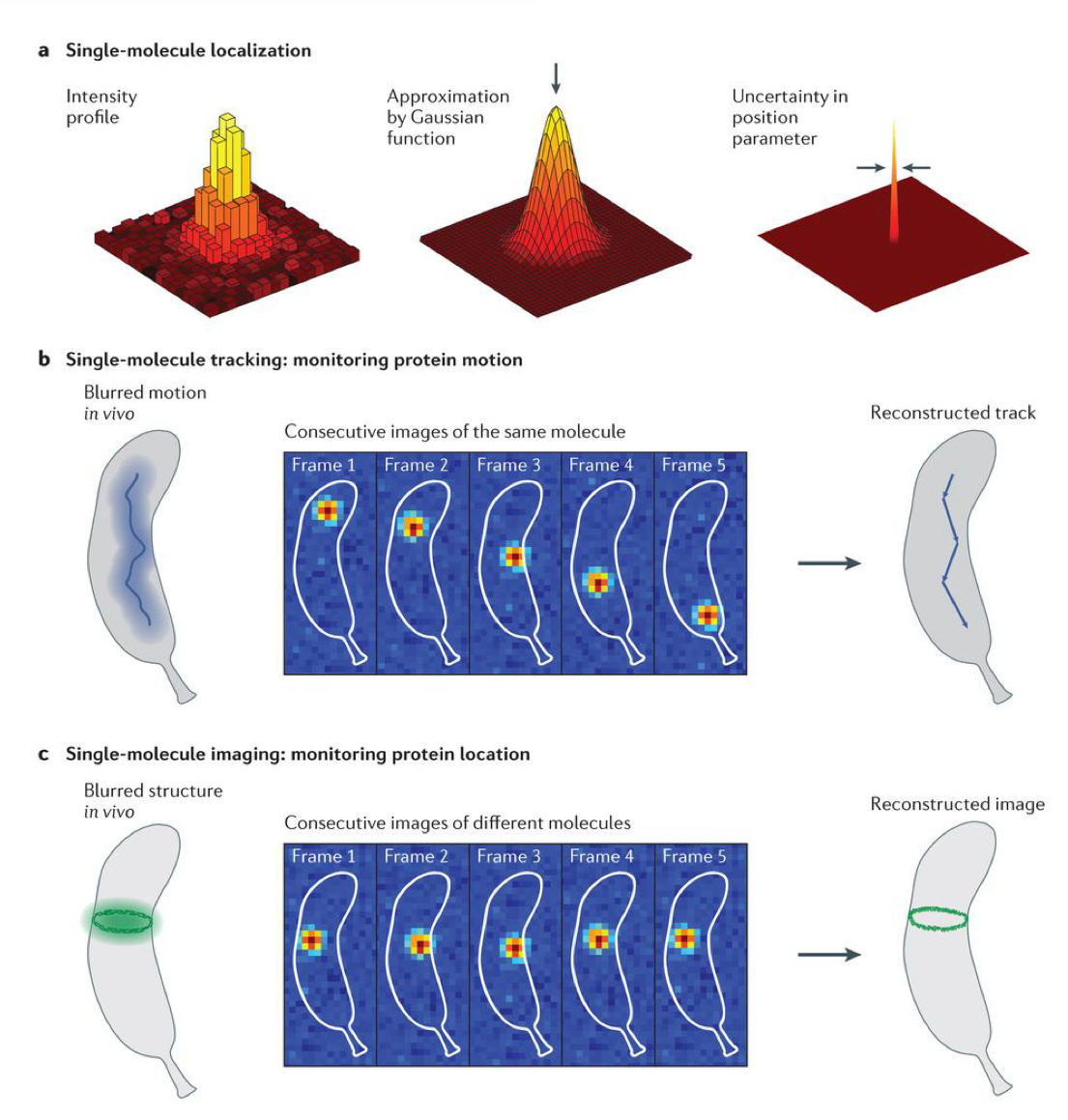Cell 201: Lecture 12 - Cytoskeleton
1/93
There's no tags or description
Looks like no tags are added yet.
Name | Mastery | Learn | Test | Matching | Spaced |
|---|
No study sessions yet.
94 Terms
What is the cytoskeleton?
Network of interconnected filaments + tubules extending through the cytosol
What Role do cytoskeletons play?
Cell movement + division
Moving vesicles around
structure + shaping
True or False: The cytoskeleton is a fixed shape and doesn’t change often
False: it is dynamic + Changable
What are the 3 Main families of cytoskeleton components? List from largest to smallest
Microtubules
Intermediate filaments
Microfilaments
What are each of the 3 Families of cytoskeleton components made up of?
Microtubules = tubulin
Intermediate filaments = Actin
Microfilaments = various proteins
How are each of the 3 cytoplasmic components located/arranged?
Intermediate = around nucleus + Provide strain relief off plasma membrane. Involved in cell to cell connections
Microtubules = emanate off the same area
Actin = Periphery = maintain shape of PM
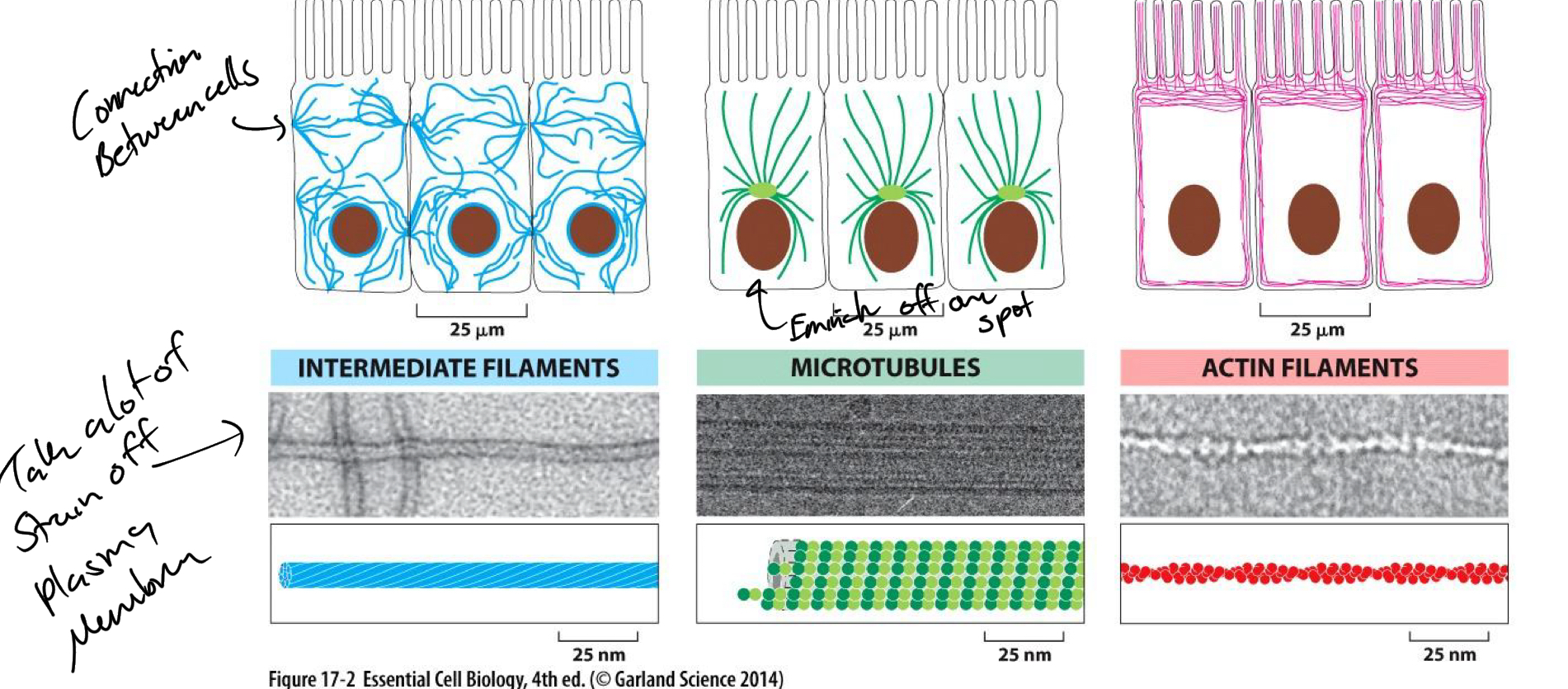
What is the structure of Intermediate filaments?
8 protofilaments joined end to end with staggered overlaps
Is there polarity in intermediate filaments?
No
no chemical distinction between either end
What are some functions of intermediate filaments?
structural support
Maintenance of cell shape
Formation of nuclear lamina + scaffolding
Strengthening of nerve cell axons
Keeping muscles fivers in register
What is the main distinction between the intermediate filaments + the other 2?
No polarity
the other 2 have polarity
Why are microtubules + microfilaments polar?
their monomers assemble in a specific repeating way
What is the structure of Microtubules?
Hollow tube with a wall consisting of 13 protofilaments
protofilaments are made up of alpha beta heterodimers
What is the polarity of the microtubules
They have a + and - end
One end is all Alpha
One end is all beta
What are some functions of microtubules?
Cytoplasmic
Organization + maintenance of cell shape + polarity
Chromosome movement
Intracellular transport/trafficking + movement of organelles
Cell motility
What is the structure of Microfilaments?
2 "intertwined” chains of F actin
made up of G-actin monomers subunits are pointing the same way
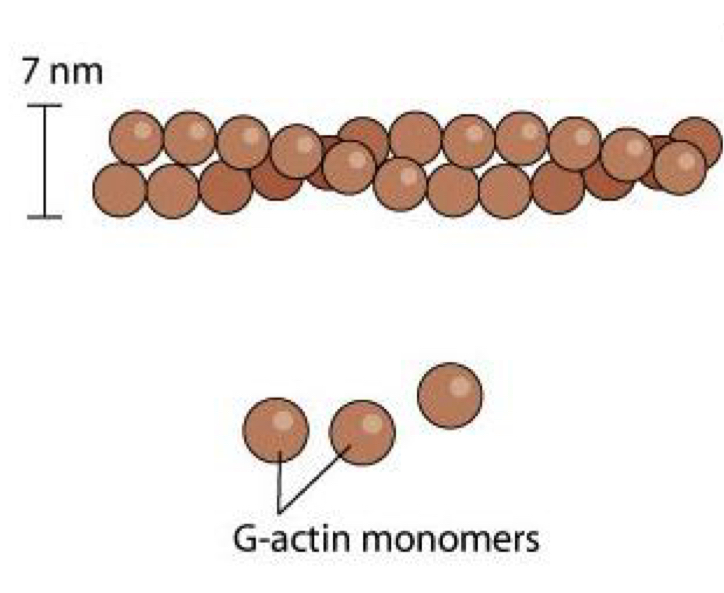
What is the polarity of the microfilaments
They have a + and - end
G actin subunits have a polarity + are assembled head to tail
What is the difference between F vs. G actin?
F actin = the polymer of the monomer ==> FILAMENT
G actin = GLOBULAR single monomer
same protein diff assembly
What are some functions of Microfilaments?
Muscle contraction
cell locomotion
Cytoplasmic streaming
Cytokinesis
Maintenance of cell shape
Intracellular transport + trafficking
What are some tool (4) used to study the cytoskeleton?
Fluorescence microscopy (fixed specimens)
Live cell fluorescence microscopy (tag the subunits)
Computer enhanced digital microscopy (subunits are too small so need computers)
Electron microscopy
True or false: there are naturally produced substances that affect cytoskeleton
True
Drugs affecting Microtubules microfilaments
What is an example of a drug that affects the cytoskeleton?
Cytochalasin D
prevent new monomers from adding to + end of Microfilaments
True or false: Bacteria + archaea have cytoskeletal systems that are structurally similar to those in eukaryotes
TRUE
Bacteria + archaea have polymer systems that function similarly to eukaryotic cytoskeleton elements
In bacteria the actin-like _____ protein is involved in DNA segregation
MreB
In bacteria the Tubulin-like _____ protein is involved in regulating division
FtsZ
In bacteria _____ protein is involved in regulating cell shape (curving of cell)
Crescentin
Super resolution microscopy. What is it used for + how does it work?
For really small things, obtain HIGHER RESOLUTION than microscope can offer using GAUSIAN Distribution (esp. bacteria where things are really small)
What is the largest of the cytoskeleton components?
Microtubules
How do microtubules look?
Ends are not flat bc protofilaments line up in spirals.
What are the 2 types of microtubules?
Cytoplasmic
Axonemal
What are cytoplasmic microtubules? What do they mainly do? (3 things)
Moving chromosomes around during cell division (mitosis + myosis spindles)
Maintaining/ altering shape
Placement + movement of vesicles
What are Axonemal microtubules? What do they mainly do?
Mainly in Motility organelles structures
cilia + flagella
What is the axoneme?
Central shaft of a cilium or Flagellum
highly ordered bundle of microtubules
What are protofilaments?
The longitudinal arrays of polymers that make up Microtubules (hollow cylinder shape)
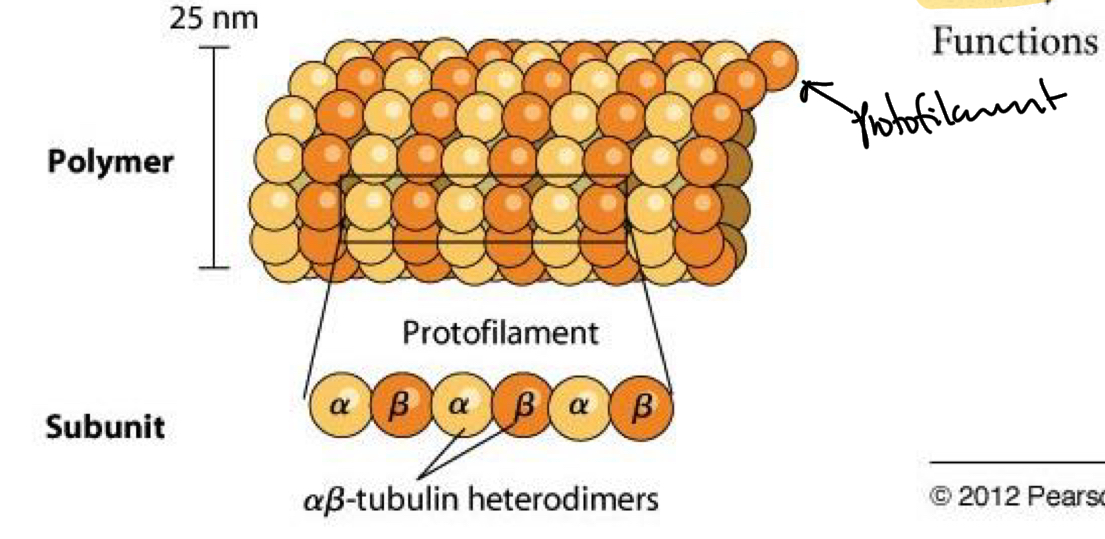
What is the basic subunit of a protofilament?
Heterodimer
Alpha tubulin
Beta tubulin
What Interaction/bond holds the alpha-beta hetero dimers together? Do they ever come apart?
Non-covalent bonds
never come apart
one of the strongest non-covalent bonds in biology
Alpha and beta subunits are very _____ (similar/different) in their 3D structure and very ______(similar/different) in their A.A. sequence
Very SIMILAR 3D structure but only 40% a.a. identity
DIVERGENT IN SEQUENCE but FOLD INTO SAME STRUCTURES
What can Alpha + Beta subunits bind to?
GTP they are NUCLEOTIDE BINDING PROTEINS
Where does GTP bind to in Alpha + Beta subunits?
N-terminus
What does GTP binding do?
Conformation change
Both alpha + beta are GTP binding proteins are both of them GTPases? Why or why not?
No both of them are not GTPases. ONLY BETA is GTPase
GTP bound to alpha = trapped between B + a and can never be hydrolyzed
GTP bound to beta is exposed and can be hydrolyzed
What does the C-terminus of a-B subunits associate with?
MAPs (microtubule associated proteins)
Microtubules have polarity: + and - because of the dimer orientation resulting in polarity in the protofilaments. Which subunit of the dimer is associated with the + end and which is associated with the - end?
PLUS end = Beta tubulin (GTP exposed)
MINUS end = Alpha tubulin
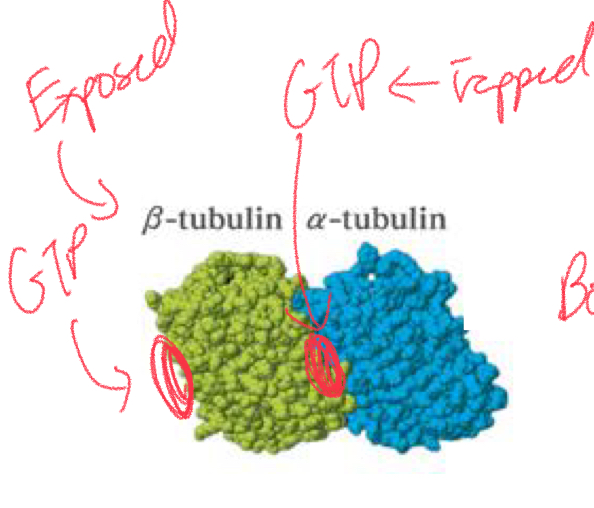
Which end ±/-has a higher affinity for new dimers?
Plus end = higher affinity therefore called the plus end
Minus end = where subunits are preferentially misused
What are the GTP states at each end on the polymer? Why?
Plus end = GTP bound because they are being added
Minus end = GDP bound = fall off
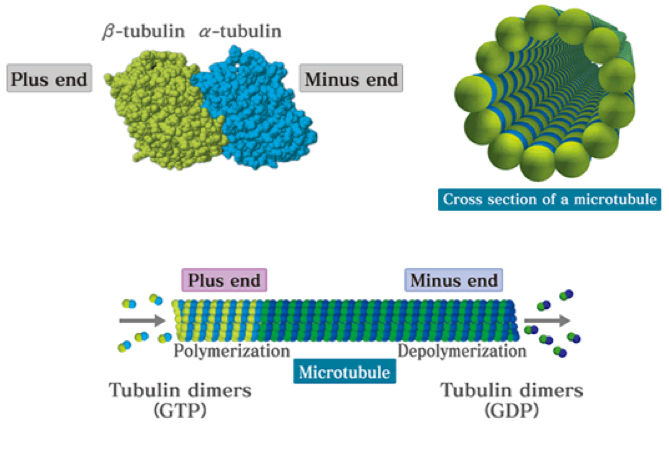
Which of the 2 types of microtubules can form doublets or triplets?
Axonemal
cytoplasmic are only singlets (A)
In doublets and triplets, how many protofilaments do each of the additional microtubules have?
NOT 13
A (singlet) = 13
B/C = 10 or 11
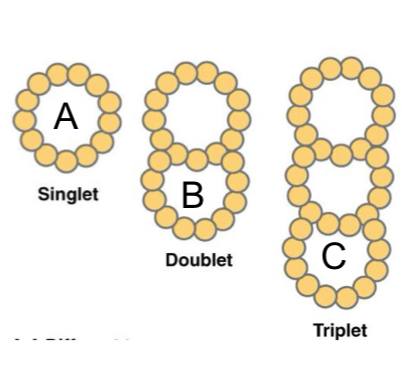
How are Microtubules formed. What 2 things are needed for the polymerization of tubulin dimers?
GTP
Mg2+
= polymerization
What role does GTP play in microtubule assembly?
GTP = dictates how tightly bound dimers are
GTP state = more sticky
GDP state = less sticky = fall apart
How does changing the [heterodimers] affect the rate of microtubule assembly?
Higher concentration = more collisions = faster assembly
Is the polymerization of tubulin subunits reversible?
Yes
What is the polymerization process of dimers into protofilaments called?
Nucleation
What is Elongation + how does it differ from nucleation?
Elongation = the addition of subunits onto a partially formed microtubules
Nucleation = initial formation of protofilaments
What does the in vitro assembly of microtubules depend on?
concentration of tubulin dimers
What are the 3 phases of In vitro Microtubule assembly? What is the speed at each phase + why?
Lag: Nucleation process is slow
Elongation = very fast
Plateau = slow down: Amount of available tubulin is low. Rate as assembly = disassembly
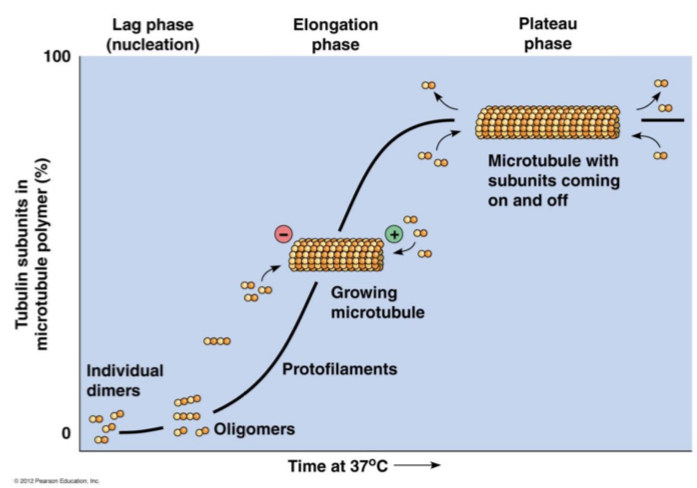
What is Critical concentration?
Tubulin concentration at which Microtubule assembly is exactly balanced by disassembly
What occurs above + below critical concentration?
Above = tubule gets longer
Bellow = tubule gets shorter
How does microtubule disassembly occur? Why does it happen when subunit concentrations are low?
GTP bound Subunits bind + add = form a GTP CAP
Hydrolysis comes from the back and travels towards the cap like a wave
If assembly is too slow, hydrolysis will catch up + reach the end = the GDP subunits will fall off
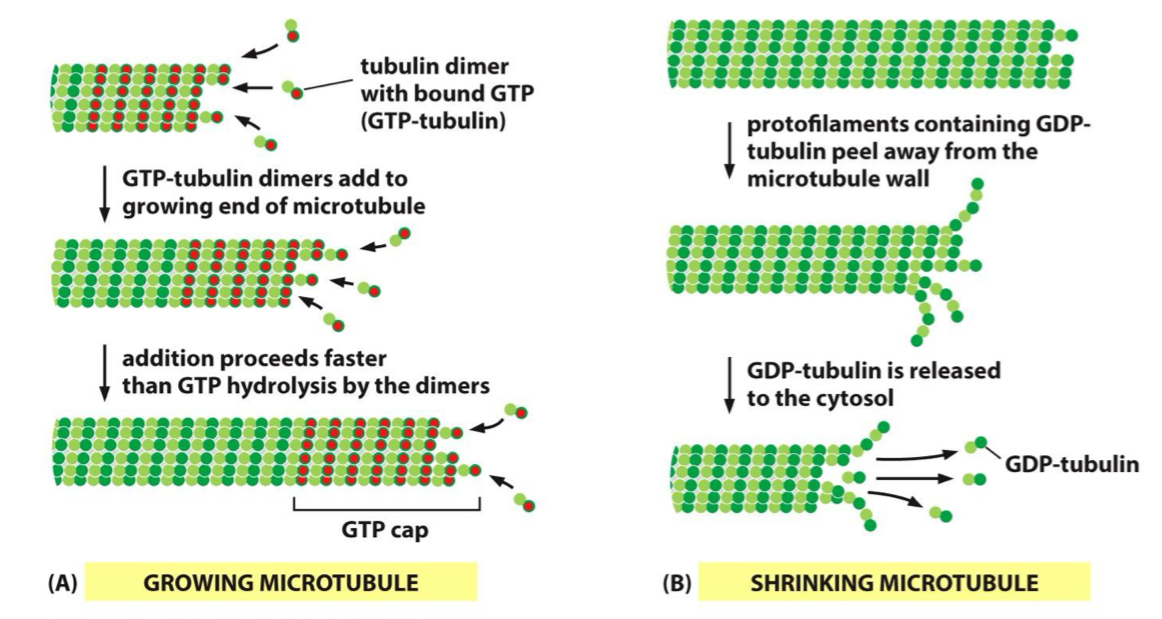
Why is the GDP bound state of the microtubule subunits fall off while GTP stays stuck?
GTP bound subunits are in ALIGNMENT = stay stuck
GDP bound = OUT OF ALIGNMENT. Without cap = curl outwards + start to peel off
What is the function of the GTP CAP?
GTP CAP holds the out of alignment GDP together. If hydrolysis reaches end = no CAP to hold together = fall + peel apart
Stabilizes the Microtubule
The addition of tubulin dimers occurs more quickly at which end of the microtubule? How can this be visualized?
Quick = Plus end
visualize with Basal body
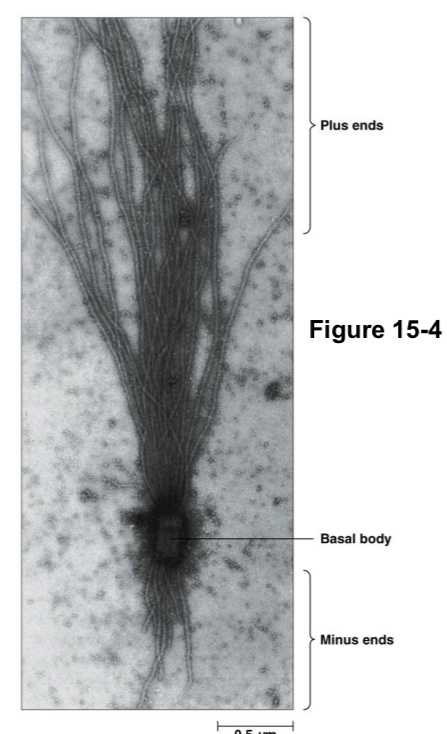
Are the Critical concetrations’s the same for the plus + minus end of microtubules?
NO
Minus end is less sticky = need higher critical concentrations to meet the rate of polymerization at the plus end
at same concentration minus end polymerizes slower
What is Treadmilling?
Addition of subunits at plus = removal at minus
MT length doesn’t change
What [tubulin'] does there have to be in relation to each end for treadmilling to occur?
[tubulin subunit] = higher than critical concentration for Plus end but lower than minus end?
Is it possible to have a net addition of tubulin subunits at the minus end?
YES
just need a ton of subunits in order to exceed the critical concentration
What is Microtubule catastrophe?
switch from growth to loss
What is Microtubule Rescue?
Switch back from loss to growth
If the Microtubule disassembles how does that affect the [dimers]?
[dimers] increases
rescues the MT
Dynamic Cyclization between Catastrophe and rescue as disassembly increases dimers available driving growth
Drugs can affect the assembly of Microtubules. What are the 2 drugs talked about?
Colchicine
Nocodazole
What does Colchicine do?
Binds to tubulin heterodimers + inhibits their assembly + promotes disassembly
decreases the concentration of assembly competent heterodimers = amount of collisions that result in assembly = low
often used for gout
What does Nocodazole do?
Inhibits MT assembly
Which effects are more easily reversed? Colchicine or Nocodazole?
Nocodazole
What are Antimitotic drugs + what do they do? What are they useful for? Give 2 examples.
Interfere with spindle formation = inhibit cell division
Useful in cancer treatment
eg. Colchicine + Nocodazole
Where do microtubules originate from?
MTOC
microtubule organizing centers
What is a MTOC that many cells have near the nucleus
Centrosome
What are centrioles?
Inside Centrosomes. 2 of them are part of Centrosome in animal cells
What is the structure of centrioles?
9 pairs of triplet microtubules oriented at right angles to each other
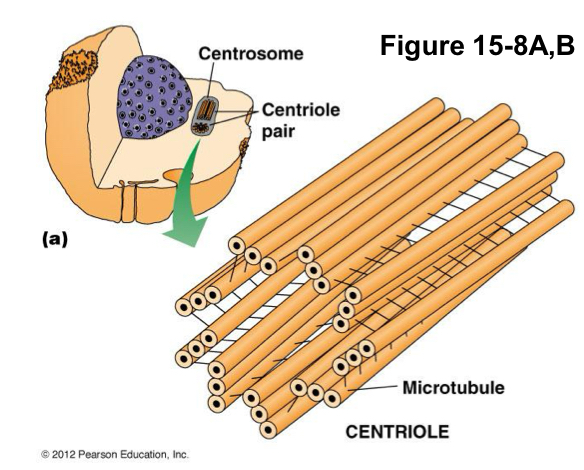
What are the functions of centrioles? (2)
Organizing microtubules
Basal body formation for Cilia + flagella
What do cells without centrioles often have?
Poorly organized mitotic spindles
What is Gamma Tubulin? What does it do?
Involved in NUCLEATION of a+B tubulin
where MTs grow from
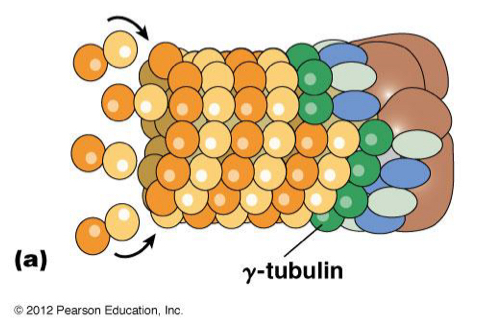
What is gamma tubulin part of/ where is it located?
Part of Ring shaped protein complexes in the CENTROSOME
Which end of the MT is anchored to the gamma tubulin?
minus end
plus end is growing outward
What are these Ring shaped protein complexes called + what do they do?
Gamma-tubulin ring complexes
nucleate the assembly of new MT
In what direction does the MT assemble in relation to the centrosome?
away
What are the functions of MAPs + what are they?
Microtubule Associated proteins
bind at regular intervals along MT
Allows for interaction with other cellular structures + filaments
What are 2 examples of MAPs?
Tau
MAP2
What does Tau proteins do?
Cause MTs to form tight bundles in axons
Bundling proteins (prevents them from getting tangled)
What does MAP2 do?
Bundles MT in dendrites ( a little looser bundling)
What are +TIP proteins? What do they do?
PLUS end tubulin interacting proteins
they RECRUIT + collect tubulin dimers tot he plus end = increase collision rate
Stabilize the dimers at plus end + prevent peeling back of heterodimers
DECREASE likelihood of MT catastrophic subunit loss/ disassembly
What are some examples of MT destabilizing proteins?
Catastrophins (MCAK)
Katanin’s
Why are MT destabilizing proteins important?
needed for mitotic spindle functions
What do Catastrophins do?
Promote peeling of subunits at plus end
What do Katanin’s do?
Sever/cut through MTs
generate 2 pieces out of one
How does MT disassembly help in mitotic spindle formations
Peeling of MT = forces a ring around the MT in the direction of depolymerization
Centromere of DNA = attached to ring = getting pulled along as MT depolymerizes
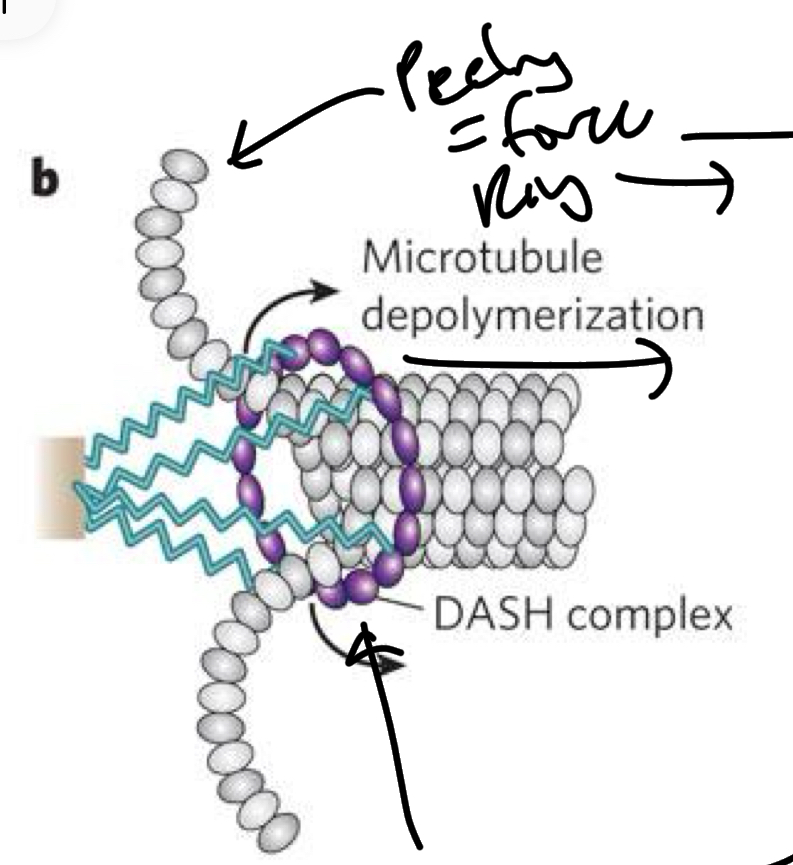
What is Speckle microscopy? How does it work? Why/what is it used for ?
Look at large assemblies made up of tiny pieces + see their specific functions
eg. since tubulin so small, if all were tagged with fluorescence. Everything would just look green you cant distinguish them and look at their functions
Only tag a small number of proteins in the polymer + look at their function + movement in the larger assembly
